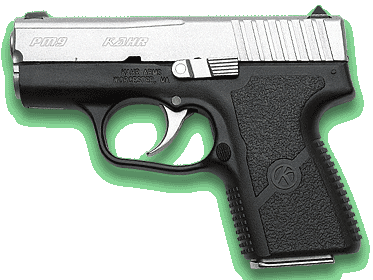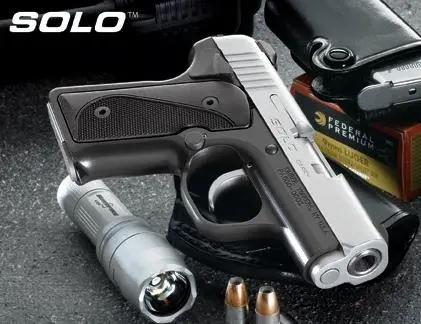 |
 |
|
Compared: Kahr PM9 and Kimber Solo 9x19mm Subcompact Pistols By Chuck Hawks and the Guns and Shooting Online Staff The Kahr PM9 and Kimber Solo, both made in the USA, are two of the best subcompact pistols on the market for concealed carry. Both are short recoil operated autoloaders chambered for the powerful 9x19mm (9mm Luger) cartridge. Six shot, single stack magazines minimize grip length and overall width. This makes them thinner and lighter than the double stack, 10 shot, 20 ounce, Glock 26 sub-compact. These are usually called "double action only" pistols, but they are not true double actions, lacking any second strike capability with a second trigger pull (trigger cocking). Although they use different internal designs from each other and from the seminal Glock action, conceptually--like the Glock--they are "safe action" type pistols. The trigger pull is such that the pistol is not likely to be fired accidentally. The long, quasi double action trigger pull and a striker block that is deactivated during the trigger stroke are the primary safety features in both the Kahr and Kimber pistols. Like a Glock, the shooter need only refrain from pulling the trigger to keep the pistol safe to carry, particularly in a fanny pack or holster that covers the trigger. Unlike a Glock and the Kahr, the Kimber adds a manual thumb safety to the mix. The Kimber's ambidextrous manual safety (up for "safe," down for "fire") blocks the sear to prevent release of the striker. However, even if you ignore the manual safety the little Kimber is inherently a safe firearm. Both pistols have some sort of loaded chamber indicator. In the Kahr, the extractor protrudes slightly from the right side of the slide, which can be seen in good light and felt in the dark. The Kimber has a small hole drilled in the top rear of the chamber through which the edge of the rim of a chambered cartridge can be seen, at least in good light. The Kahr system is better. Both of these pistols are cleverly designed to provide consistent, smooth trigger pulls for all shots. Our Kahr's trigger released at about six pounds and the Kimber's trigger released at about 6.5 pounds. Strangely, the Kimber's trigger felt lighter than the Kahr's trigger to the Guns and Shooting Online staff members who dry fired the two pistols side by side, before I measured their trigger pulls with an RCBS deluxe pull gauge. I suspect this is because the Kimber has a noticeably shorter trigger travel. Both pistols have wide, smooth, pivoted triggers. The Kimber trigger has a little more curve than I prefer, but not enough to cause a problem. Both pistols feature a matte silver stainless steel slide and trigger and a black frame. However, the Kahr's frame is matte black polymer and the Kimber's frame is aluminum with a black, semi-gloss "KimPro" finish. Kimber also offers a heavier Solo with a stainless steel frame. The Kahr's lines are sort of squared off, while the Kimber's lines are more rounded. They are both good looking little pistols, but we preferred the appearance of the Kimber. The Kahr's textured gripping surface is molded into the grip frame. The Kimber was supplied with black plastic grip panels. Like most pistols with metal frames, these are attached by two screws and are removable. The grip angles are the same, modeled on the Colt 1911 pistol. Both grips are short, only providing room for the middle and ring fingers of the shooting hand. The little finger curls below the grip. This does not bother me, as I often shoot pistols this way, but it bothered Jim Fleck, our Chief Technical Advisor. Jenn, our Custodial Engineer, a woman with average size hands, preferred the feel of the Kimber. The Kahr claims a 3" barrel and the Kimber a 2.7" barrel. In reality, because autoloading pistol barrels are measured including the chamber, the effective barrel length is about an inch shorter in both pistols. There isn't much difference, but a longer barrel is better. The slides stay open after the last shot. With very short barrels, both pistols need powerful slide return springs that make manually racking their slides a chore, particularly in the case of the Kimber. This is partly due to the Kimber's more rounded slide and smaller slide catch, as well as an ungodly strong spring, which makes it very difficult to manually retract the slide and lock it open. When the slide is locked back, it takes a lot of pressure on the Kimber's tiny release lever to drop the slide. Both guns' slides have deep gripping serrations, but the Kahr's gripping area is larger. It is easier to get a grip on the Kahr's squared slide and larger slide stop. The Kimber's super strong spring also makes it difficult to hold the slide back for removal of the slide stop to field strip the pistol for cleaning. The Kahr's slide is easier to operate. The magazine releases are at the rear of the trigger guard and the stainless steel magazines drop free when the button is depressed. The Kahr's release button is polymer with a small metal insert that catches the magazine. This magazine release has proven to be subject to wear if you insist on slamming the stainless steel magazine home. It is better is to hold the button in when inserting a magazine into the Kahr. The Kimber's ambidextrous magazine release is a steel part and wear should not be a problem. Visually, the Kimber looks a little smaller, probably because of its more rounded contours, but it isn't. Dimensionally, there is very little to choose between these two pistols. With magazines in place, the Kahr measures 3.978" from the bottom of the magazine to the top of the slide and the Kimber measures 3.760". The Kahr measures 0.920" in width through the middle of the grip and the Kimber measures 0.957". The Kahr measures 0.902" in width through the slide just forward of the chamber and the Kimber measures 0.920". In overall length from the muzzle to the back of the frame behind the slide, the Kimber measured 5.410" and the Kimber 5.470". A tenth of an inch here or there isn't going to matter. On our digital scale, the Kahr weighed 16.5 ounces with an empty magazine and the Kimber weighed 17 ounces. For all practical purposes, these two pistols are the same size and the sight radius is nearly identical. Here are the manufacturers' specifications for each pistol. Kahr PM9 Specifications 
Kimber Solo Carry Specifications 
Both pistols come with dovetail mounted Patridge sights that are drift adjustable for windage. The Kahr's front sight wears a white dot and the rear sight has a vertical white bar below the notch. The Kimber's sights are the familiar three white dot type. Both pistols provide a better sight picture than most pocket autos, but we liked the Kimber's sights better. They are a little bolder, with a wider rear notch. The break-in instructions for these two pistols are quite different. Kahr says to fire at least 200 rounds to break-in a new pistol before reliable operation is assured. Kimber says to fire 24 rounds. Kahr suggests no ammunition restrictions and I usually shoot Winchester/USA 115 grain JHP loads in mine. Kimber recommends using only premium factory loads with 124-147 grain bullets. They warn that loads using lighter bullets may compromise reliability, which we found to be true. Kimber specifically recommends Federal Premium Hydra-Shok JHP, Remington Golden Saber JHP and Hornady TAP JHP factory loads. For less expensive practice ammo, try Remington/UMC, Winchester/USA, Speer Lawman or Federal American Eagle 124 grain or 147 grain ball. Accuracy wise, pocket autos generally leave something to be desired. However, subcompact nines are, in our experience, somewhat more accurate than similar size .380s and these two pistols tend to confirm this. The Kahr is good for about 4" groups at 25 yards and the Kimber averaged 2.6" groups at 25 yards. I'd have to give the advantage in intrinsic accuracy to the Kimber. In a life and death situation, group size is likely to increase dramatically. These are not target pistols and they are not particularly easy to shoot accurately from unsupported positions. The short sight radius means that even the slightest sighting error is dramatically magnified downrange. I took the opportunity to chronograph the Remington/UMC 115 grain Metal Case factory load in the Kahr and found the average velocity at 10 feet from the muzzle to be 1030 fps with an extreme spread of 42 fps. The advertised velocity of this load is 1145 fps from a 4" barrel, so I was pleasantly surprised by the little gun's performance. The Kahr, well broken-in at the time of this comparison, was completely reliable. The Kimber, newly arrived for review and never before fired, experienced both a failure to feed and a failure to extract in its first 50 rounds. An admittedly unfair comparison, but based on our limited testing I have to favor the Kahr for reliability. There is considerable muzzle blast from the short barrels and recoil is noticeably sharp, although not actually painful. The Kahr seemed a little easier on the hand. These are the sort of guns you carry a lot and shoot a little. One must shoot often enough to keep in practice, of course, but these are not fun pistols for recreational shooting. They are, however, capable of saving your life in an emergency. Whether you choose the Kahr PM9 or the Kimber Solo Carry will probably come down to personal preference. Each has its advantages. Both are relatively expensive subcompact pistols. However, you should expect to pay more for the best. Note: Individual reviews of both these pistols can be found on the Product Reviews page. |
Copyright 2012, 2016 by Chuck Hawks. All rights reserved.
|
|